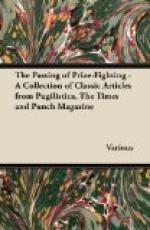Charming story, isn’t it? I shall write again soon.
Yours, in the meantime,
Diogenes Robinson.
* * * * *
Night-mailing.—“Night Mail between London and Paris” has been recently announced in all the papers as now ready and willing to take night-mailers from Victoria, L.C. & D., to the French Capital. It is to be a Third-class Night Mail, though a Knight of the First Class can, of course, travel by it should he be so disposed. Thirty shillings through fare for “a single;” but as the tariff doesn’t explicitly inform us whether the passenger will be asked the question, “Married or single?” and so be charged accordingly, we may presume that a margin is left for a little surprise. The train of Night Mails—a kind of gay bachelor train, no females being of the party—is to start at 8:15 P.M., and to be in Paris at 5:50 A.M.
* * * * *
Drawing the Badger.
(A Natural History Note.)
[Illustration]
The Badger (Meles-Taxus) is at once one of the most inoffensive and (in one sense) offensive of our few remaining British Carnivora. He is described by Napier of Merchiston, in his Book of Nature and of Man, as a “quiet nocturnal beast, but if much ‘badgered’ becoming obstinate, and fighting to the last, in which it is a type of a large class of Britons, who like to be let alone, but when ill used can fight.”
That great new authority on Natural History, Mr. G.A. HENTY (author of Those Other Animals), should be able to tell us much about the Badger. Therewith he would be able, in his own favourite fashion, to “point a moral” (against the Demogorgon Democracy), and “adorn a tale” (of laboured waggery). He might find the subject as suggestive of sardonic chaff as American women and Republican institutions.
What says the popular Wood? He describes the Badger as “slow and clumsy in its actions,” and as “rolling along so awkwardly that it may easily be mistaken for a young pig in the dusk of the evening.” Woe, however, to whomsoever does take the creature for “a young pig.” “Being naturally as harmless an animal as can be imagined, it is a terrible antagonist when provoked to use the means of defence with which it is so well provided.”
We tax the patience of poor Meles-Taxus,
Until he turns with tooth and claws and
whacks us.
The natural home of Taxus—the
Exchequer—
Harbours a creature that keeps up its
pecker.
“For the purpose of so-called ‘sport,’ the Badger used to be captured and put into a cage ready to be tormented; at the cruel will of every ruffian who might chose to risk his dog against the sharp teeth of the captive animal.”
This particular sort of “sport” is a little out of date. But “drawing a Badger” is not unknown even in these humanitarian days. Dogs will sometimes voluntarily rush in to risk their hides and muzzles against the aforesaid sharp teeth, &c. Look at those in the picture!




